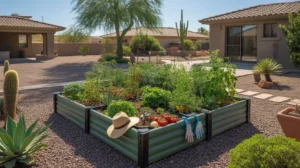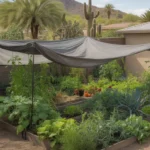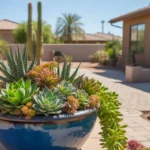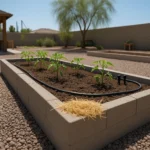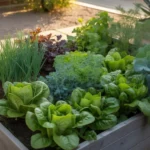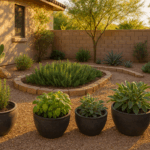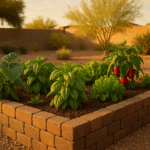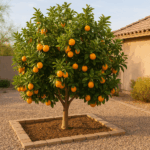Gardening in the harsh Mesa desert can feel like an uphill battle, with scorching sun and water-repellent soil. But what if you could create a self-watering oasis that keeps your plants thriving, even in the toughest conditions? Enter wicking beds: the raised bed solution that’s turning sun-baked Mesa yards into bountiful gardens.
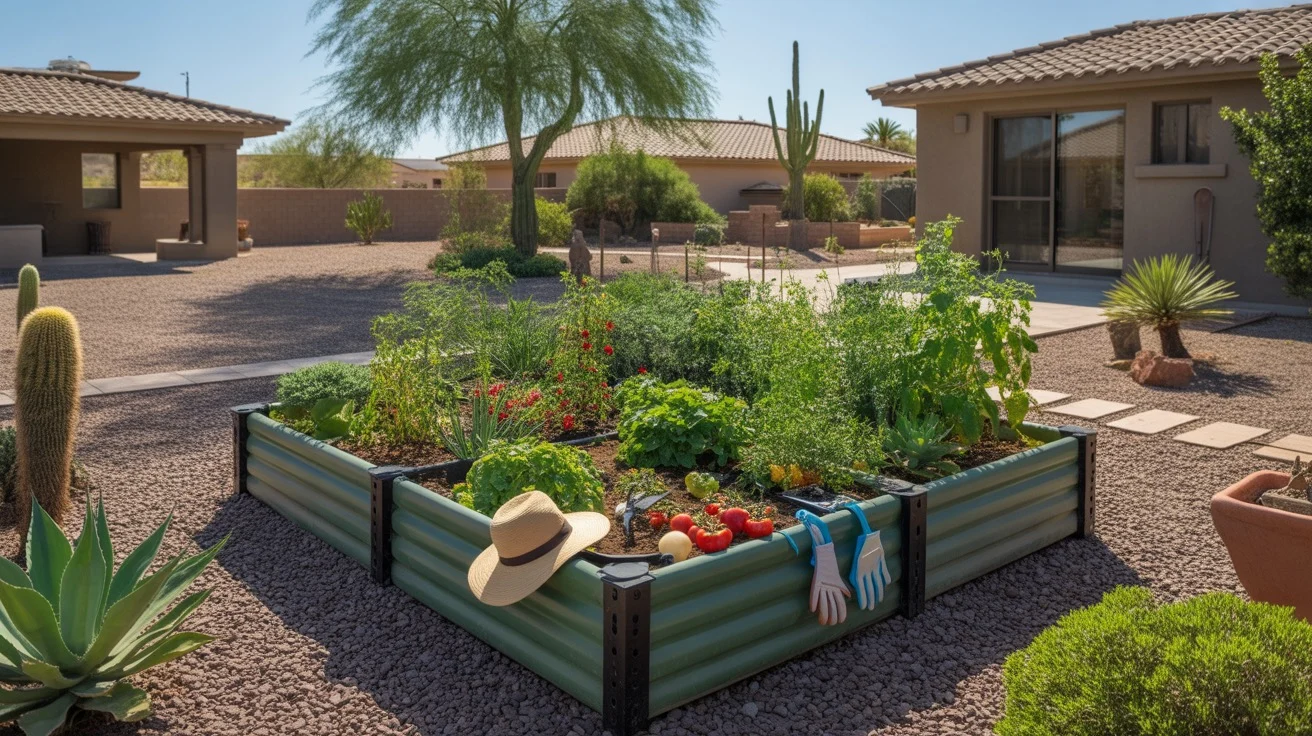
What Are Wicking Beds?
Wicking beds are a type of raised garden bed that uses a self-watering system to keep plants consistently moist. They work by storing water in a reservoir at the bottom of the bed, which then “wicks” up through the soil via capillary action. This means your plants can access water as needed, without you having to constantly monitor and irrigate.
The key components of a wicking bed are:
- A waterproof liner to contain the reservoir
- A fill pipe for adding water to the reservoir
- An overflow drain to prevent waterlogging
- A wicking medium (like gravel or sand) to draw water up
- High-quality soil mix on top for planting
When built correctly, a wicking bed can go for days or even weeks without needing to be refilled, making them a game-changer for Mesa’s intense summer heat.
Why Wicking Beds Work Wonders in Mesa
Mesa’s desert climate presents unique challenges for gardeners. Our soil is lean and quick-draining, making it difficult to keep plants consistently moist. High temperatures and intense sun exposure can also cause water to evaporate rapidly, stressing plants and stunting growth.
Wicking beds solve these problems by creating a controlled environment for your plants. The steady water supply from the reservoir keeps roots moist without waterlogging, while the raised design improves drainage and aeration. The bed walls also provide some shade and protection from harsh winds.
This combination of consistent moisture, improved soil structure, and microclimate control allows vegetables, herbs, and flowers to thrive in Mesa conditions where they might otherwise struggle. You’ll be amazed at the difference a wicking bed can make!
Building Your Mesa Wicking Bed
Ready to create your own wicking bed oasis? Here’s a step-by-step guide:
- Choose a location that gets at least 6-8 hours of sun per day.
- Build or buy a raised bed frame at least 12″ deep and sized to fit your space. Cedar or composite materials work best in Mesa’s heat.
- Line the bottom with pond liner or heavy-duty plastic, extending it up the sides. This creates your waterproof reservoir.
- Install a fill pipe at one end and an overflow drain at the other, about 2-3″ above the bottom.
- Fill the bottom 4-6″ with gravel or coarse sand. This is your wicking layer.
- Add a sheet of geotextile fabric on top of the gravel to prevent soil from clogging it.
- Fill the rest of the bed with a high-quality, moisture-retentive soil mix. A blend of compost, coco coir, and perlite works well for Mesa.
- Thoroughly water the bed from the top, then fill the reservoir via the fill pipe. Allow it to absorb overnight before planting.
With your wicking bed built, you’re ready to plant your favorite vegetables, herbs, or flowers and enjoy a thriving Mesa garden!
Wicking Bed Planting Tips for Mesa
While a wicking bed provides ideal growing conditions, there are still some Mesa-specific tips to keep in mind when planting:
- Choose heat-tolerant, desert-adapted varieties whenever possible. Look for plants that can handle intense sun and high temperatures.
- Provide shade for sensitive crops during the hottest months. Shade cloth, lattice, or companion planting with taller plants can help.
- Plant in successions to avoid having all your crops mature at once. This spreads out the harvest and minimizes waste.
- Monitor the reservoir level regularly and top up as needed. In the height of summer, you may need to refill weekly.
- Mulch the soil surface to reduce evaporation and keep roots cool. Straw, dried leaves, or grass clippings work well.
With these tips in mind, your Mesa wicking bed will be a productive and low-maintenance addition to your yard.
Maintaining Your Wicking Bed Through the Seasons
As with any garden bed, your wicking bed will need some regular TLC to keep it functioning optimally. Here’s a seasonal maintenance guide for Mesa:
Spring: Before planting, top up the reservoir and flush it to remove any stagnant water. Add fresh compost and amendments to the soil as needed. Check the liner and pipes for any cracks or clogs.
Summer: Monitor water levels closely and refill as needed. Harvest regularly to encourage continued production. Watch for signs of heat stress and provide extra shade or water if necessary.
Fall: As temperatures cool, adjust watering frequency accordingly. Plant cool-season crops like greens and root vegetables. Clean up spent plants and add them to your compost pile.
Winter: In Mesa’s mild winters, you can continue growing cold-tolerant crops in your wicking bed. Keep an eye out for frost warnings and protect plants if needed. This is also a good time to do any repairs or upgrades to the bed structure.
With proper maintenance, your Mesa wicking bed will provide years of abundant harvests and gardening enjoyment.
Companion Planting in Wicking Beds
One of the beauties of wicking beds is the ability to plant intensively and create beneficial plant communities. Companion planting involves grouping species that support each other through pest control, nutrient sharing, or environmental modification.
Some winning combinations for Mesa wicking beds include:
- Tomatoes + basil + marigolds: Basil improves tomato flavor, while marigolds repel pests.
- Peppers + oregano + petunias: Oregano provides ground cover and pest control, while petunias attract pollinators.
- Eggplant + beans + nasturtiums: Beans fix nitrogen to feed eggplants, and nasturtiums act as a trap crop for aphids.
- Squash + corn + sunflowers: Corn provides a trellis for beans, which feed the heavy-feeding squash, while sunflowers attract beneficial insects.
By grouping compatible plants in your wicking bed, you can create a diverse, self-sustaining ecosystem that maximizes your harvest and minimizes pests and disease.
Wicking Bed Inspiration: Mesa Gardens to Visit
Want to see wicking beds in action? Check out these Mesa gardens for inspiration and ideas:
- Mesa Community College Center for Urban Agriculture: This teaching garden showcases various raised bed designs, including wicking beds. See how they integrate irrigation and companion planting.
- Vertuccio Farms: While not a public garden, this Mesa U-pick farm uses wicking beds to grow its famous strawberries and vegetables. Peek over the fence to see large-scale wicking systems at work!
- Agritopia Community Garden: This Gilbert neighborhood garden has several member plots that feature wicking beds. Note the creative trellising and season extension techniques used.
By visiting these local examples, you can glean practical tips and design ideas to implement in your own Mesa wicking bed garden.
With a bit of planning and effort, wicking beds can help you turn Mesa’s toughest gardening challenges into an opportunity for abundance. By providing consistent moisture, improved soil, and a controlled microclimate, these self-watering raised beds allow you to grow a wider variety of crops with less stress and water waste. So why not give wicking a try and watch your Mesa garden thrive?

